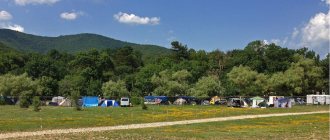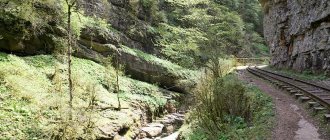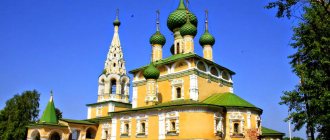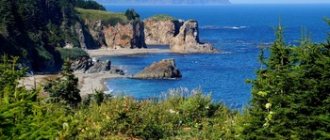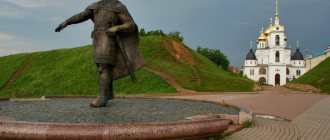Gudauta is an Abkhaz town on the shores of Gudauta Bay of the Black Sea, famous for its luxurious sandy beaches, comfortable hotels and sanatoriums. Tourists come here to enjoy the sun, sea and lazy relaxation on a sun lounger. But the tourism potential of Gudauta lies not only in the developed beach infrastructure. Guests of the resort should pay attention to the cultural and historical attractions of the city, visit the ruins of ancient buildings and magnificent parks that reflect the beauty of Abkhazia.
Gudauta resort: what a tourist can see in 1 day
You should start your trip around Gudauta with the most popular and attractive places for tourists. The so-called “highlights” of the resort can be visited in one day.
The building of the department store "Gunda"
- Address: Heroev Avenue.
One of the most beautiful buildings in Gudauta was built in 1909. It is a two-story structure with a trapezoidal base. The facades are decorated with patterned pilasters, white stone platbands, panels and a carved frieze.
The front porch is decorated with snow-white columns and an archivolt; directly above it there is a window niche with an arched frame and stucco high relief. The building is painted in a catchy berry color, and the decorative elements are covered with plaster, which makes them even brighter and more noticeable. The pompous composition is completed by a through belfry, inside of which a massive bell is installed. The belfry is topped with a tent with a tower spire and decorated with a large round clock.
Initially, the building housed the elite Imperial Hotel. In the 1990s, attackers started a fire in one of the premises, as a result of which the building suffered serious damage, and the adjacent outbuildings burned to the ground.
Today the building has been restored and houses the main department store of the city, named after the female name Gunda. The restoration did not damage the historical appearance of the building, preserving the slightest decorative elements and wall paintings from a century ago. Currently, “Gunda” is a symbol of Gudauta and its most recognizable landmark.
Gudauta Winery
- Address: Gagra highway.
The plant was founded in 1953 as a private winery. Just a few years after the opening of the enterprise, the products produced gained fame and wild popularity.
Master winemakers working at the plant create drinks according to national Abkhaz recipes. Tourists visiting the winery will have a tour of the production workshops, vineyards, and at the end, guests will be offered a tasting of the legendary Abkhaz wine. Here travelers will be able to appreciate and taste wine of all sorts (including the famous Ritsa wine), as well as vodka and cognac.
There is a store at the plant where anyone can buy a bottle of their favorite drink.
Gudauta wine is loved by connoisseurs from different parts of the world, and visiting its ancestral homeland is a great honor and privilege. This is what the Gudauta people think.
Church of the Assumption of the Blessed Virgin Mary
- Address: Gudauta district, village of Lykhny, Lykhny Agu.
A few kilometers from the city, in the ancient village of Lykhny, there is a cross-domed church built at the turn of the 10th and 11th centuries. The building is made of smooth rows of carefully polished ash-gray stones.
The roofs are located at different levels; in the center there is an octagon with a small dome. The entrance to the temple is decorated with an arch with massive vaults. Nearby there is a three-tiered bell tower on a cubic base, topped with a cross. Around the building, part of the fence wall, made of round stones, has been preserved.
Of particular value in the medieval church are the frescoes created in the 14th century under the influence of Byzantine art, as well as several wall inscriptions in Georgian and Greek.
On the territory of the church there is the burial place of Safar Ali Bey Chachba-Shervashidze, an Abkhaz prince who died in the first half of the 19th century.
In 2007, the Church of the Assumption of the Blessed Virgin Mary was recognized as a cultural monument of national importance in Georgia. This is one of the most ancient operating temples in Abkhazia.
Gunda Department Store
The Gunda department store with its clock is called the heart of Guduata, its symbol. For a long time it was in a deplorable state; the chimes did not work. In 2022, the historical building was reconstructed, the façade stucco was restored, oak entrance doors and wrought-iron balconies were installed, and the clock was repaired.
The department store was built in Art Nouveau style in 1909. At first the Imperial Hotel was located here, during the NEP there was a currency store here, then a department store. It is believed that the clock on the bell tower of the building came from the New Athos Monastery in 1924.
Unique architecture of Gudauta
In terms of architectural development, Gudauta is a truly special city. Here you can see not only modern complexes, but also buildings of the 19th-20th centuries, as well as the ruins of ancient buildings, the owners of which were the princes of Abkhazia. Tourists can visit many interesting buildings within the city and in the surrounding area.
Railway station building
- Address: Vokzalnaya Square.
The railway station was built in 1944. The architectural style and decoration of this building are quite unusual for a Soviet-era building.
The station is designed in antique style. The vault of its roof is supported by a number of high columns, and the window niches are decorated with grapes made of wood. The interiors are also amazing. The ceiling and walls are framed with stucco patterns, a wide marble staircase leads to the second floor, and the waiting rooms are filled with green indoor plants and palm trees.
The magnificent building suffered damage during the Georgian-Abkhaz conflict, and restoration work is now underway.
Music school building
- Address: st. July 23, 2.
The unusual building in the eclectic style was erected at the beginning of the last century. The stone structure attracts attention with an unusual element - an octagonal tower extension. The white tower ends with a jagged roof, rising above the subtropical forest like a medieval castle.
Like most buildings in Gudauta, this building was damaged during the civil war and is currently in dire need of restoration.
Architectural ensemble on the seashore
Several years ago, Gudauta architect Igor Smyr created an unusual architectural ensemble in the style of Antiquity. On the seashore, he erected a stone colonnade reminiscent of the Greek Parthenon, as well as a model of a dilapidated fortress and a rotunda, which shines like a pearl against the backdrop of the azure sea.
The ensemble is complemented by high reliefs made in stone massifs. These are portraits of heroes of Greek and Abkhaz legends. Igor Smyr created amazingly beautiful sculptures of people and animals from sand and small stones. The composition is completed by thickets of palm trees and flowers.
The architect put a lot of effort into this project for one purpose - to give joy to his fellow countrymen and decorate his beloved city. He did both. The master’s man-made oasis has become a popular place for walks and romantic dates, as well as a platform for photo shoots and wedding ceremonies. Guests of Gudauta should definitely visit this ancient corner and take a photo as a souvenir.
Ruins of the Chachba-Shervashidze Palace
- Address: Gudauta district, village of Lykhny, Lykhny Agu.
In the historical village of Lykhny there is a unique architectural complex - the ruined summer residence of princes from the Chachba-Shervashidze dynasty. The stone structure dates back to the 10th-11th centuries. It is unknown on whose initiative the palace was built.
There is a legend according to which the building began to collapse the day after the completion of the work. The prince demanded an explanation about the chief architect, and he replied that the gods would not allow the palace to be completed until the people made a human sacrifice.
The prince saw this as an opportunity to take revenge, which he had been dreaming about for several years. The fact is that the beauty who lived in the village of Lykhny rejected the prince’s offer to marry him and preferred a simple young man from a poor family.
By decree of the prince, the newlyweds were captured and walled up alive at the base of the palace. After making this sacrifice, the construction was completed, and the building gained strength, thanks to which it stood for centuries.
The Chachba-Shervashidze family ruled Abkhazia until 1866. After the death of the last legal representative, the people rebelled against the monarchical regime. The rebels destroyed the palace, and since then it has been in ruins.
Today, the former princely residence attracts the attention of tourists with its mystery. The spirit of history is felt in it, and the tragedy that lies at its foundation (literally and figuratively) adds a shadow of romantic sadness to the appearance of the ruins.
Train Station
Gudauta railway station was built in 1944 in the Stalinist Empire style. For a long time it was an adornment of the city, but is now abandoned and in disrepair.
It has not been repaired for more than three decades.
Entertainment in Gudauta for children and adults
Gudauta parks, museums and theaters attract tourists with their originality and a huge selection of pastimes. Such places will appeal to both adults and children.
Park of Culture and Leisure named after B.Z. Gunba
- Address: Chachba street.
In the middle of the last century, there were very few parks in Gudauta, and the vegetation was poor and sparse. The architect N.Z. Nesis decided to correct this deficiency. He began construction of a park, which later became not only a popular leisure area, but also the greenest corner of the resort.
The park is literally buried in thickets of ornamental plants and flower beds. Alleys of palm trees and fruit trees stretch along the walking paths. The main attraction of the park is the mulberry tree, whose age exceeds three centuries.
Workers of the Sukhumi Botanical Garden made a significant contribution to the development of the park. Thanks to their efforts, such rare plants as tulip lyriodendron, red Japanese maple, large-flowered magnolia and spirea appeared here.
Since the 2000s, the park regularly hosts chess and domino tournaments, cultural and entertainment events, concerts, sports competitions and children's parties. Attractions are open for younger audiences: trampolines, a shooting range, a playground, carousels and a Ferris wheel.
The numerous historical monuments installed in the park are of particular value to the city. The memorials are dedicated to military events and heroes who sacrificed their lives for the freedom of their homeland.
Museum-reserve "Abazgia"
- Address: Marganiya street.
The creation of the museum was planned for 1992, but due to the outbreak of the Georgian-Abkhaz conflict, the project had to be postponed.
The museum opened its doors in 1994. The exhibition is located in the building of a former Greek school. Exhibits flocked to the museum from all corners of the Republic. Valuable artifacts were donated by exhibition centers in other cities, school museums, as well as townspeople who preserved antiquities in their personal archives.
Currently, the tour takes place in four exhibition halls. The first two are dedicated to the events of the Georgian-Abkhaz war and the victims of this national conflict. The third hall tells about the prehistoric history of Abkhazia, displaying the fossil remains of primitive creatures.
The fourth hall is dedicated to the ethnography of Abkhazia. Here you can see examples of decorative and applied arts, women's and men's national costumes, musical instruments, products made of wood, clay and stone, as well as read literary masterpieces of Abkhaz writers and poets.
A visit to the Abazgia Museum-Reserve is a must on a sightseeing tour of Gudauta. It will take no more than two hours to go around all the halls.
Palace of Culture
- Address: st. Mahadzhirov, 4.
The Palace of Culture really resembles a royal mansion. It is a magnificent building in the classicist style. It is decorated with relief pilasters with antique capitals the same as on the colonnade at the main entrance. Slender white stone columns support an elegant portico with a crenellated cornice.
The Palace of Culture hosts theatrical performances and musical concerts, most of which reflect the national flavor and cultural characteristics of Abkhazia. Folk dances, songs and fairy tales brought to life on stage will undoubtedly impress tourists.
It is also worth visiting the festivals organized by the groups of the Palace of Culture. Such events are not complete without tastings of national dishes, mass dancing in colorful costumes and fireworks.
"Biscuit Yard"
- Address: Trapsh street.
“Biscuit Dvor” is the best confectionery shop in Gudauta. Here you can taste fluffy pastries, cakes of all shapes and sizes, as well as pies and buns baked according to Abkhazian recipes. National dishes are very popular, for example, khachapuri, baklava, Turkish delight, halva and so on.
In the “Biscuit Yard” you can relax with a cup of herbal tea and have a snack between visits to the resort’s attractions.
Gudauta market
- Address: 4th March Street.
Shopping lovers should definitely go to the Gudauta market. The trading area is filled with stalls and shops where you can buy:
- sweets;
- fresh fruits and vegetables;
- textile items;
- clothes;
- seasonings;
- wine;
- meat and fish products;
- Tea coffee.
Wool products are in great demand: knitted socks, hats, mittens, as well as souvenirs, which are sold in large quantities and are varied.
Tasting room
The Gudauta wine and vodka distillery was opened in 1953 and soon became famous throughout Abkhazia thanks to the original recipe of the wines produced here. The production volumes were impressive - up to one and a half thousand tons of wine drink per month.
At the end of the 80s, the plant closed and stood idle for thirty years. Today it operates again, as a private enterprise. There is a tasting room here, where visitors are offered to try different types of wine, and then purchase the drink they like. The most popular wine is Ritsa.
Gudauta memorials and monuments
On the streets of Gudauta there are often memorials dedicated to the difficult times that the Abkhaz people had to endure. These compositions serve as a tribute to the memory and respect of the innocent victims of military conflicts and the heroes who defended their homeland.
Memorial to the victims of the Lat tragedy
- Address: Chachba street.
On a December day in 1992, an Mi-8 helicopter with refugees on board took off from the occupied city of Tkvarcheli.
The helicopter was supposed to land in Gudauta, but this never happened. Twelve minutes after takeoff, it was shot down by a live missile fired by Georgian troops. The helicopter crashed near the village of Lata. All 87 people, including 8 pregnant women and 35 children, died.
The remains of the victims were buried in a mass grave on the territory of the Gudauta park named after O. Gunba. The monument above the burial is a high granite stele. At its foot you can see the bronze figure of a woman bending over in agony. There are also slabs with the names of the victims of the Lat tragedy.
Every year, on December 14, Gudauta residents gather in the park to honor the memory of the innocent victims and lay flowers. Among them are men and women who did not wait for their loved ones to return.
Monument to the defenders of the city during the Great Patriotic War
- Address: Lakrba street.
The monument was erected on Heroes Avenue in 1981. Sculptor M.E. Eshba and architect T.K. Lakerbaya created an impressive memorial composition, in the center of which is a bronze figure of a woman raising a lit torch.
Behind it are two bronze plates with bas-reliefs depicting military operations at the front and the rear life of soldiers' families. The memorial is installed on a high platform. In its center the Eternal Flame burns.
Monument to the defenders of the Motherland in the Patriotic War of 1992-1993.
- Address: Heroev Avenue.
The majestic memorial is located on the Avenue of Heroes near the Abazgia Museum.
This is a granite statue of an ordinary Abkhaz warrior who gave his life during the Georgian-Abkhaz conflict. He is dressed in a national costume, a long cloak falls from his shoulders. Behind the sculpture rises a rock mass, shaped like a hurricane. The Patriotic War of 1992-1993 was like a destructive tornado that claimed thousands of lives.
The background of the memorial is a white stone wall with memorial inscriptions in the Abkhaz language.
Monument to Soviet pilots
- Address: Guda and Uta Park.
The monument is dedicated to two Soviet pilots: V.I. Klyuchnikov and S.I. Sitnikov. In January 1968, their plane performed maneuvers near Gudauta.
As a result of a drop in oil pressure during the flight, the plane caught fire and, flying over the roofs of residential buildings, crashed onto the roadway. A few seconds later an explosion occurred. The pilots did not have time to eject and died in the fire.
A monument to the victims was erected in Hood and Uta Park. It is a stone arrow, on the pedestal of which there are memorial plaques with the names of the pilots and the dates of their lives.
Monument to the victims of the Georgian-Abkhaz war in the village of Lykhny
- Address: Solidarity passage.
The village of Lykhny is the place from which the Abkhaz liberation movement began. It was here that a people's meeting was organized in 1989, where the Abkhazians decided to secede their country from Georgia.
The desire to gain independence became the impetus for the beginning of the Georgian-Abkhaz conflict. During the war of 1992-1993. thousands of people died. In memory of them, a large-scale memorial complex was opened in the village of Lykhny.
The monuments are made of stone. Here you can see free-standing sculptures depicting Abkhaz warriors, as well as stone massifs with bas-reliefs. In the center of the complex there is a chapel-gazebo.
The small building looks like an arch topped with an octagon with a cross. Adjacent to the arch is a semicircular niche in which you can light a candle in memory of the heroes of the Patriotic War.
Mysra village
The village of Mysra (Myussera) is located on the territory of the Pitsunda-Myussera Nature Reserve on the Black Sea coast.
Musser Temple (Ambara)
Most guests of Abkhazia consider it obligatory to visit another attraction of Gudauta - the Mussersky Temple, built in the 10th - 11th centuries. It is often called Ambara after the name of the river whose mouth is located nearby.
Time, unfortunately, has not been kind to this once monumental complex: it is badly damaged and covered in ivy. But from the surviving fragments one can understand how impressive and majestic this structure was. Today, the southern part of the building is most notable, with its arched windows and columns. The dilapidated staircase leading upstairs has also been preserved.
The temple is located 17 km west of Gudauta, on the territory of the Myussersky Nature Reserve. Oaks, boxwood, dogwood and hazel grow here. The area itself is called Abkhaz Switzerland.
Stalin's dacha
A kilometer from Pitsunda Bay in the Myussersky Nature Reserve is Stalin’s dacha. Of the five Abkhaz dachas, it was built first - in 1932, on the site of the estate of oil industrialist Lionozov. Stalin liked the dacha and visited it several times. From here you can see beautiful views; you can go down to the sea along the long grand staircase.
In addition to the dacha itself, there is a building with a winter cinema and a billiard room and a building with a swimming pool.
N.S. Khrushchev also loved to visit this dacha. Now there are group excursions every hour.
Gorbachev's dacha
Near (300 meters) from Stalin’s rather small dacha, a luxurious dacha for Gorbachev was built in 1989 - the Chaika-M facility. He himself had never been there; the construction was led by his wife Raisa Maksimovna. The decoration of the palace was carried out by Zurab Tsereteli. There is a swimming pool, cinema, billiards and beautiful sea views.
The famous 20-meter bronze chandelier
Currently, Gorbachev's dacha in Mysra is the residence of the President of Abkhazia. Excursions are held here, and part of the palace is rented out to wealthy vacationers.
Sculptural compositions of the Gudauta resort
In addition to historical monuments, Gudauta contains many sculptures of a decorative nature. They decorate the city and lift the spirits of passers-by.
Sculptural ensemble "Rodnichok"
- Address: pos. Friendship.
“Spring” is another creation of the Gudauta architect Igor Smyr. The sculptural ensemble is located on the outskirts of the city, near the village of Druzhba. It consists of two white stone figures:
- a horse nursing a foal;
- girl drawing water in the shade of a decorative tree. A spring of cold drinking water flows from the jug she holds in her hands.
Igor Smyr created this nice composition on his own initiative. The appearance of “Rodnichka” was a real surprise for the townspeople, because the architect worked in secret.
Sculptures of Guda and Uta
- Address: Guda and Uta Park.
According to legend, the name of the city comes from the youthful name Guda and the maiden name Uta. Guda and Uta loved each other dearly and dreamed of getting married, but a long-standing discord between their families prevented their happiness.
When Goode's parents once again forbade him to even see his beloved, he headed to the river and drowned himself. Upon learning of this, Uta rushed to the shore in tears. The girl did not want to live in this world without the friend of her heart, and followed him into the abyss.
A beautiful legend, reminiscent of the story of Romeo and Juliet, is strongly connected with the culture of Gudauta. One of the most picturesque parks of the resort is named after the lovers - “Guda and Uta”.
There, on the green lawn, there are snow-white sculptures of a young man and a girl. This place is very popular among lovers and newlyweds. People often make dates and arrange wedding photo shoots here.
Otkhara village
The village of Othara is located at the foot of the Bzyb ridge. There is a famous rock monastery and a trout farm here.
Rock Monastery
The Otkhara rock monastery is carved right into a sheer rock at an altitude of 50 meters from the ground.
Initially, it was believed that this structure was created by nature itself: it was located in such an inaccessible place. But research carried out in the 50s confirmed that the monastery was man-made: household items dating back to the Middle Ages were discovered. The monastery was founded as a refuge: proof of this were the loopholes directed towards the path leading to the rock.
Trout farm
At the mouth of the Mchishta River, in the village of Othara, there is one of the oldest trout farms: it was founded back in 1934 and provided the entire Black Sea coast with fish. Today the enterprise is far from its former capacity, but it is still of considerable interest to visitors: here you can watch how trout are bred, follow all the stages of its growth and feed it.
The sights of Gudauta will also delight lovers of gastronomic tourism. There is a fish restaurant where your chosen trout will be roasted over a fire.
Natural attractions of Gudauta and its surroundings
Landscapes of Gudauta have inspired more than one generation of artists and poets to create vivid paintings and magnificent poems. But artistic canvases and perfectly chosen words cannot reflect the beauty that a person sees with his own eyes. Tourists should travel to secluded corners of Abkhazian nature to enjoy it to the fullest.
Gudau River
- Coordinates on the map: 102867, 40.635412.
The fact that the name Gudauta comes from the names of two lovers is a beautiful fairy tale written by the Gudauta people. In fact, the city received its name in honor of the Gudau River, which flows through its territory.
The stormy current of the Gudau runs along the rocky bed, filling the city with ringing overflows. The banks of the river are also rocky and stretch along the thickets of subtropical forest. There are fishermen's huts and recreation centers here, and bridges cross the river in several places.
Tourists visit Gudau to enjoy the silence, admire exotic flowers and palm trees, fish for small fish and take beautiful photographs.
Azlagara River
- GPS coordinates: 43.102867, 40.635412.
Azlagara flows parallel to Gudou. The main type of entertainment is fishing. The river contains large numbers of grass carp, bullheads, loaches, chubs, brook trout and catfish. There are hotels along the coast, but there are no fishing equipment rentals here. Fishermen are advised to take everything they need with them.
Hot hydrogen sulfide springs
- Coordinates: 43.100173, 40.751033.
The village of Primorskoye is located not far from Gudauta and attracts tourists with its healing springs. Near the point where the springs emerge to the surface, a health complex has been built, the infrastructure of which includes swimming pools, a massage department, mud baths, showers and a cafe.
The balneological complex is located in a picturesque location. A river with small waterfalls flows on its territory, and since the pools are located in the open air, tourists will be able to admire beautiful views during procedures.
Hot hydrogen sulfide springs promote rejuvenation and overall health of the body. Before visiting, you should familiarize yourself with the rules for taking baths and consult a doctor.
How to get there
Citizens of the Russian Federation will not need a foreign passport to enter the territory of Abkhazia. It is enough to take a regular internal one with you. You also don’t have to worry about exchanging currencies – the Russian ruble is accepted in Abkhazia. In addition, almost every resident of Abkhazia knows Russian.
There are several ways to get to the resort town of Gudauta:
- Flight from any city in Russia to Adler. Then you need to cross the border and call an Abkhaz taxi, which will take you to your destination. There is a convenient option to call a taxi directly to Adler.
- Train Moscow – Sukhum. The advantage of this method of travel is that you go through customs directly in the train carriage, but the disadvantage is that the trip takes a long time.
- A comfortable train runs from Adler to Gudauta. When choosing this method of travel, you need to pay attention to the schedule - it changes often.
A trip to Gudauta will not cause any special problems for vacationers. In addition, during the trip you can enjoy the beautiful landscapes of the country.
The best beaches in Gudauta
After visiting the resort's attractions, you can also lie on the beach. For a lazy holiday, Gudauta has several corners where tourists will enjoy relaxing and swimming.
Central Beach
- Address: Chamagua street.
The most popular beach of Gudauta is located within the city. The sandy coastline stretches for three kilometers. The entry into the sea is gentle, safe, without sharp stones, which makes the beach ideal for families with children.
Despite the crowds of people, the water here is always clear and the sand is clean. Due to the length of the beach, you can always find a secluded place on it. Even in high season it doesn't get too crowded.
On the territory of the Central Beach there are cafes, changing cabins, dry closets and rental points for umbrellas and sun loungers. The main entertainment on the beach is a banana ride. This attraction will amuse both children and adults.
Gold Coast Beach
- Address: st. Embankment, village Mgudzyrkhua.
“Golden Coast” is a pebble beach, popular in July and August, and practically deserted in the remaining months. There is a hotel of the same name located on the shore. The area associated with it is comfortably developed, and the rest of the territory is wild.
Lovers of pristine nature relax in the shade of palm trees and swim in crystal clear water. The lack of infrastructure has its advantages: dolphins often approach the shore, and small fish swim in the water.
Mussera Beach
- Address: road to Myussera, Gudauta district.
The beach of the Mussera hotel is considered one of the best in the city. The surface is sand and pebbles, the entry into the sea is gentle. The beach infrastructure includes rental of swimming equipment (circles, bananas, sleeves), changing rooms, showers and bars. In the evenings, discos and parties are held here.
Beach in the village of Primorskoye
- Coordinates: 43.087297, 40.761364.
The pebble beach in Primorskoye is noisy and crowded. The gentle approach to the sea and shallow waters made it popular for couples vacationing with children. The beach is popular even when the swimming season is coming to an end.
A forest stretches along the coastline, in the shade of which there are wooden gazebos with tables. Villagers and visitors love to have family gatherings here, light fires and barbecue.
See also the sights of other Abkhaz cities - Gagra, Pitsunda and Sukhum
Gudauta is a wonderful resort in Abkhazia, suitable for family holidays and solo travel. Regardless of age and preferences, guests of this town will find interesting entertainment for themselves. National color, luxurious parks, vibrant sights and magnificent beaches - all these are the undeniable advantages of Gudauta.
This corner of Abkhazia is not very popular among tourists
...therefore there is no huge crowd on the beach, and nature has retained its original appearance.
Gradually, the infrastructure of the resort town is improving, and local attractions are becoming increasingly popular. Which ones should I visit? You can do it on your own or by booking a tour with local guides.
The settlement received city status only at the beginning of the 20th century. The resort has many pebble and sandy beaches, as well as many other natural, architectural, historical attractions and shrines. We will read more about the attractions and local entertainment below.
Abgarkhuk village
Fortress of Abahuaza
“Abahuatsa” translated from Abkhazian means “bonfire on the mountain.” This is no coincidence - it was the fire on top of the fortress watchtower that informed the residents of the surrounding settlements about the approach of enemy troops.
The famous medieval fortress of Abkhazia Abahuatsa is located above the Aapsta River, among forests. To get to the ruins, you need to follow a rather narrow path at the base of the cliff. The ruins of a tower have been preserved, which can be reached through a hole in the wall. Previously, it was not so easy to climb up: only along a ladder, through a narrow door.
The Abahuaza Fortress is an important historical monument and is of considerable interest to tourists.

